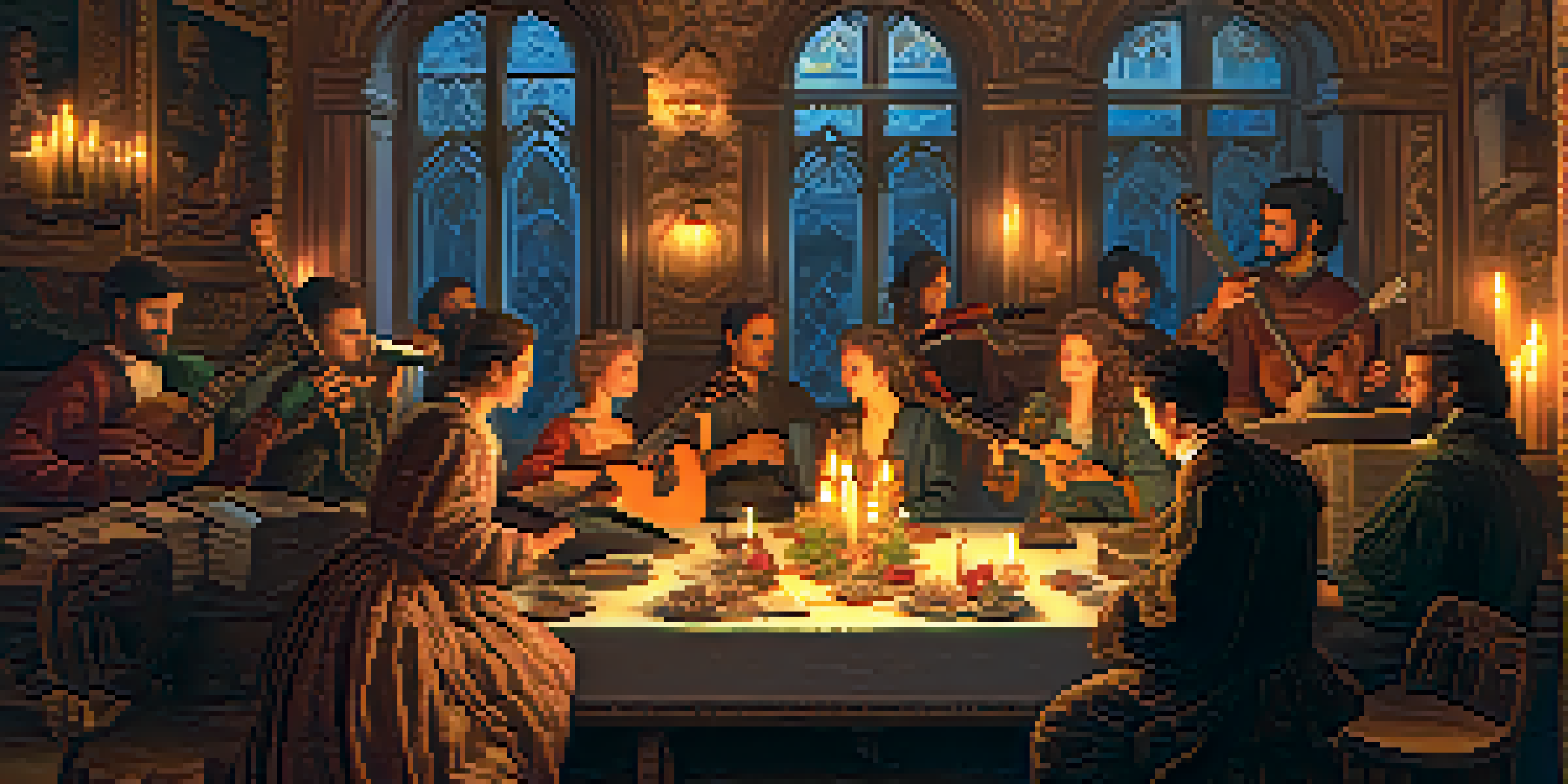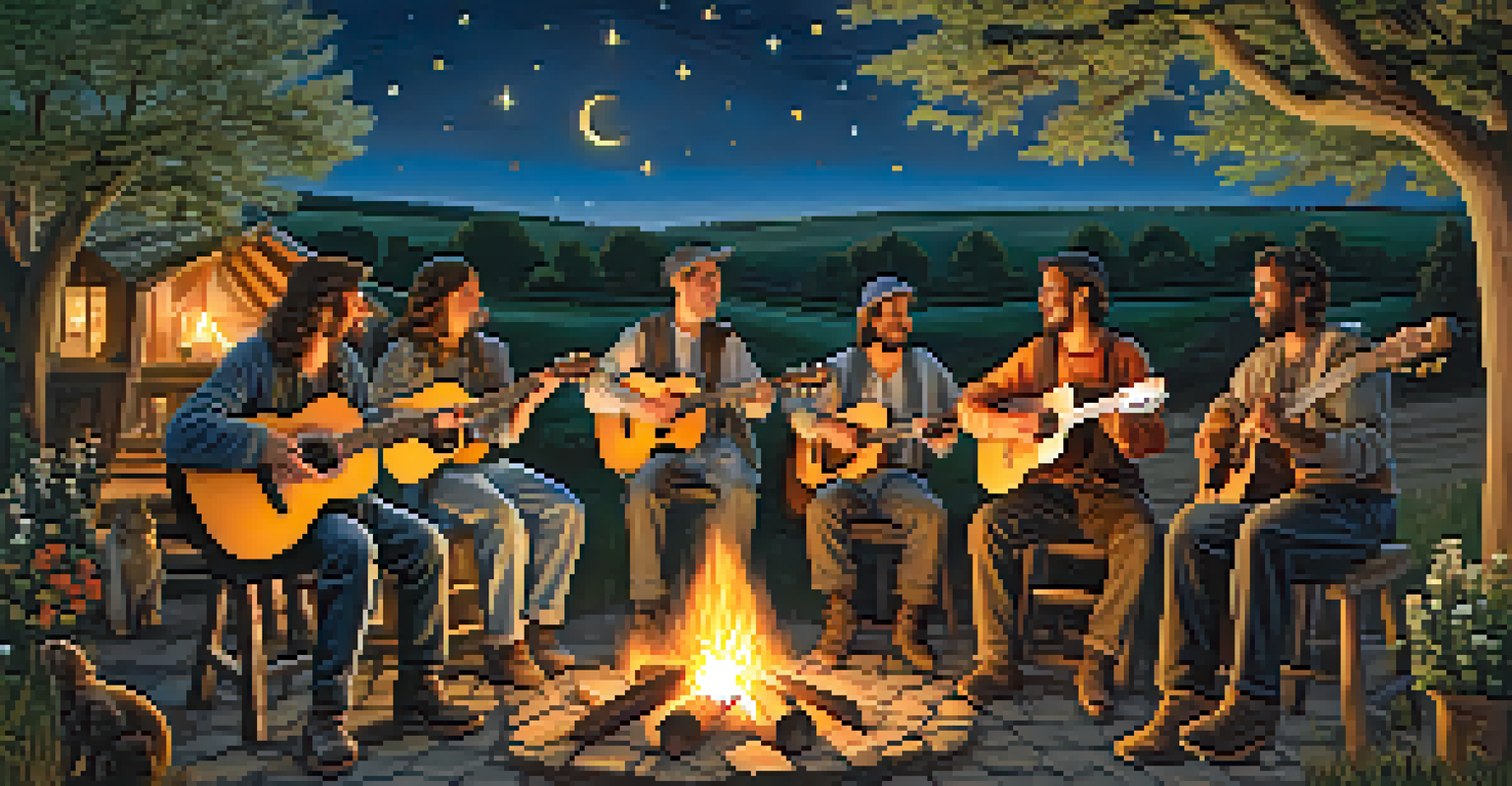Guitar in the Renaissance: A Shift in Musical Expression

The Rise of the Guitar in Renaissance Society
During the Renaissance, which spanned roughly from the 14th to the 17th century, the guitar began to emerge as a prominent instrument in European music. This period was marked by a renewed interest in arts and culture, leading to the guitar's popularity among both musicians and amateurs. Unlike its predecessors, the lute and vihuela, the guitar was more accessible and easier to play, making it a favorite choice in social settings.
Music is the shorthand of emotion.
As the guitar gained traction, it became associated with the burgeoning middle class that sought entertainment and artistic expression. The instrument was often played at gatherings, fostering a communal spirit where music became a shared experience. This shift in usage reflected broader societal changes, as music began to be seen not only as an elite pastime but a form of personal expression for everyone.
Consequently, the guitar's design evolved during this time, with innovations in construction that improved sound quality and playability. The introduction of the five-course guitar, which featured pairs of strings, allowed for more complex harmonies, paving the way for a richer musical experience. This evolution mirrored the overall transformation in artistic expression during the Renaissance.
Musical Innovations: The Guitar's New Role
The Renaissance was characterized by significant advancements in musical theory and composition, and the guitar was no exception. Composers began to explore new styles and techniques that highlighted the instrument's capabilities. This era saw the rise of tablature, a form of musical notation specifically designed for string instruments, making it easier for guitarists to learn and share music.

One of the key figures in this development was Francesco da Milano, a renowned composer and guitarist whose works exemplified the intricate harmonies possible on the guitar. His compositions showcased the instrument's flexibility, allowing for both melodic lines and complex chords. This versatility attracted the attention of musicians across Europe, further solidifying the guitar's place in the musical landscape.
Guitar's Rise in Renaissance Culture
During the Renaissance, the guitar became a popular instrument, symbolizing artistic expression and social connection among the emerging middle class.
As guitar music gained popularity, it became an essential part of the broader musical repertoire. The instrument was not only featured in solo performances but also started to accompany vocalists and other instruments in ensembles. This collaborative spirit marked a significant shift in how music was approached, emphasizing harmony and interaction among different musical voices.
Cultural Influence: The Guitar as a Symbol
The guitar's rise during the Renaissance wasn't just about music; it also reflected cultural changes and social dynamics of the time. As the instrument became more widespread, it transcended its original role, becoming a symbol of artistic freedom and individual expression. Musicians began to use the guitar to convey their personal stories and emotions, making it a powerful tool for communication.
The guitar is a remarkable instrument that can express a wide range of emotions and styles.
Moreover, the guitar's association with popular culture contributed to its status as a symbol of the Renaissance spirit. It was played in taverns, courts, and salons, connecting people from various walks of life. This accessibility helped to democratize music, allowing for a broader range of voices and experiences to be heard and appreciated.
This cultural significance continued to evolve, influencing the development of various music styles that would emerge in later periods. The guitar became a bridge between different musical traditions, linking the past to the future. Its role as a cultural icon during the Renaissance laid the groundwork for its prominence in subsequent musical movements.
Evolution of Guitar Techniques in the Renaissance
As the guitar became increasingly popular, musicians began to develop new techniques that highlighted its unique sound. Fingerstyle playing emerged as a prominent technique, allowing artists to pluck individual strings for intricate melodies. This method not only showcased the guitarist's skill but also added depth to the music, enriching the listening experience.
Additionally, the use of ornamentation became a hallmark of Renaissance guitar music. Musicians would embellish their melodies with trills, slides, and other decorative flourishes, adding a layer of expressiveness to their performances. This focus on embellishment reflected the broader artistic trends of the time, emphasizing individuality and personal interpretation in music.
Innovations in Guitar Techniques
Renaissance musicians developed new playing techniques and musical notation, enhancing the guitar's versatility and establishing its place in both solo and ensemble performances.
The development of these techniques was documented in various treatises and instructional books, which helped standardize methods and share knowledge among guitarists. These resources were crucial for musicians looking to refine their craft, ensuring that the art of guitar playing would continue to evolve long after the Renaissance ended.
The Guitar's Role in Courtly and Folk Music
In the Renaissance, the guitar found its place not only in the courts of nobility but also in the vibrant world of folk music. Its portability made it an ideal instrument for traveling musicians, who would entertain audiences in various settings, from royal courts to bustling marketplaces. This duality enriched the guitar's repertoire, blending refined courtly compositions with the lively rhythms of folk traditions.
Courtly music often featured the guitar in intimate settings, where musicians would perform for nobles and dignitaries. The instrument's soft, melodic tones complemented the lavish atmosphere, providing a backdrop for social gatherings. This association with the elite helped elevate the guitar's status, further solidifying its importance in Renaissance music.
Conversely, in folk settings, the guitar became a means of storytelling and communal joy. Musicians would gather around campfires or in village squares, using the guitar to share tales and celebrate life. This connection to the everyday experiences of people underscored the guitar's versatility and its ability to resonate across different social strata.
The Legacy of Renaissance Guitar Music
The impact of Renaissance guitar music is still felt today, as it laid the foundation for various genres and styles that followed. The techniques, compositions, and cultural significance established during this period influenced not only classical guitar music but also popular music forms that emerged in later centuries. This legacy highlights the enduring nature of the guitar as an instrument capable of expressing a wide range of emotions and ideas.
Moreover, the Renaissance period sparked a renewed interest in string instruments, leading to innovations that would shape the future of music. The guitar's evolution during this time inspired the creation of new instruments, such as the Baroque guitar, which further expanded the instrument's capabilities. This continuous development ensured that the guitar would remain a central figure in the world of music.
Legacy of Renaissance Guitar Music
The foundations laid during the Renaissance continue to influence various music genres today, showcasing the guitar's enduring significance in music history.
Today, musicians across genres—from classical to rock—draw inspiration from the rich history of Renaissance guitar music. The techniques and styles that emerged during this era continue to inform contemporary playing, reminding us of the guitar's transformative power as an instrument. The Renaissance not only changed the course of guitar history but also shaped the very essence of musical expression.
Conclusion: The Guitar's Enduring Influence
The Renaissance marked a significant turning point for the guitar, transforming it from a lesser-known instrument into a key player in the musical world. As it gained popularity, the guitar became a symbol of cultural expression, weaving together the threads of society, art, and personal identity. This evolution reflects the broader changes occurring during the Renaissance, where individual voices began to rise and be heard.
As we look back at this fascinating period, we can appreciate how the guitar's journey mirrors the quest for artistic freedom and innovation. The techniques and compositions developed during the Renaissance laid the groundwork for future generations of musicians, ensuring that the guitar would remain a beloved instrument. Its story is a testament to the power of music to connect people across time and culture.

Ultimately, the guitar's enduring influence can be seen in its continued presence in diverse musical styles today. From classical performances to modern pop songs, the instrument remains a vital part of our musical landscape, reminding us of its rich history and the creative spirit that fueled its evolution during the Renaissance.